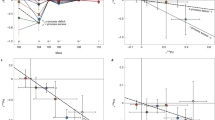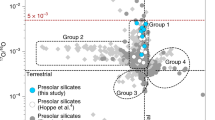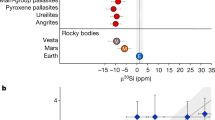Abstract
Carbon-rich ‘carbonaceous’ meteorites contain several types of dust grains with an isotopic signature that identifies them as being of pre-solar origin1,2,3. Of these grains, diamonds are of particular interest: such grains are by far the most abundant, and they host an isotopically anomalous ‘Xe-H’ component (characterized by a relative overabundance of the heaviest stable isotopes of xenon) which constitutes a notable fraction of the total amount of xenon in unprocessed ‘primitive’ meteorites. The isotope abundance ratios of this Xe-H cannot be accounted for by the canonical processes responsible for nucleosynthesis of the elements heavier than iron. An ad hoc neutron-capture process has been postulated4,5,6 to explain the observed isotope abundance ratios, but it has also been pointed out that standard ‘r-process’ nucleosynthesis (in supernovae) could work if the stable isotopes were somehow separated from their radioactive precursors in the first few hours after the explosion7. One way to distinguish between these mechanisms is to determine anomalies correlated for the heavy stable isotopes of tellurium in pre-solar diamond grains. Here we report such measurements, which support the suggestion that the isotopes were separated: the competing neutron-capture process cannot produce the observed abundances.
This is a preview of subscription content, access via your institution
Access options
Subscribe to this journal
Receive 51 print issues and online access
$199.00 per year
only $3.90 per issue
Buy this article
- Purchase on Springer Link
- Instant access to full article PDF
Prices may be subject to local taxes which are calculated during checkout




Similar content being viewed by others
References
Ott, U. Interstellar grains in meteorites. Nature 364, 25–33 (1993).
Anders, E. & Zinner, E. Interstellar grains in primitive meteorites: diamond, silicon carbide, and graphite. Meteoritics 28, 490–514 (1993).
Zinner, E. Presolar material in meteorites: an overview. Proc. Astrophysical Implications of the Laboratory Study of Presolar Materials(AIP Conf. Ser., in the press).
Heymann, D. & Dziczkaniec, M. Xenon from intermediate zones of supernovae. Proc. Lunar Planet. Sci. Conf. X, 1943–1959 (1979).
Clayton, D. D. Origin of heavy xenon in meteoritic diamonds. Astrophys. J. 340, 613–619 (1989).
Howard, W. M., Meyer, B. S. & Clayton, D. D. Heavy-element abundances from a neutron burst that produces Xe-H. Meteoritics 27, 404–412 (1992).
Ott, U. Interstellar diamond xenon and time scales of supernova ejecta. Astrophys. J. 463, 344–348 (1996).
Beer, H., Corvi, F. & Mutti, P. Neutron capture of the bottleneck isotopes 138Ba and 208Pb, s-process studies, and the r-process abundance distribution. Astrophys. J. 474, 843–861 (1997).
Reynolds, J. H. & Turner, G. Rare gases in the chondrite Renazzo. J. Geophys. Res. 69, 3263–3281 (1964).
Huss, G. R. & Lewis, R. S. Noble gases in presolar diamonds I: Three distinct components and their implications for diamond origins. Meteoritics 29, 791–810 (1994).
Clayton, D. D. Principles of Stellar Evolution and Nucleosynthesis (Univ. Chicago Press, (1983).
Kosaza, T., Hasegawa, H. & Nomoto, K. Formation of dust grains in the ejecta of SN 1987A. II. Astron. Astrophys. 249, 474–482 (1991).
Haas, M. R. et al. Velocity-resolved far-infrared spectra of [Fe II]: evidence for mixing and clumping in SN 1987A. Astrophys. J. 360, 257–266 (1990).
Chevalier, R. A. Supernova 1987A at five years of age. Nature 355, 691–696 (1992).
Wachsmann, M. & Heumann, K. G. Negative thermal ionization mass spectrometry of main group elements Part 2. 6th group. Int. J. Mass. Spectrom. Ion Proc. 114, 209–220 (1992).
Kratz, K.-L., Bitouzet, J.-P., Thielemann, F.-K., Möller, P. & Pfeiffer, B. Isotopic r-process abundances and nuclear structure far from stability: implications for the r-process mechanism. Astrophys. J. 403, 216–238 (1993).
Wasserburg, G. J., Busso, M. & Gallino, R. Abundances of actinides and short-live nonactinides in the interstellar medium: diverse supernova sources for the r-process. Astrophys. J. 466, L109–L112 (1996).
Käppeler, F., Beer, H. & Wisshak, K. S-process nucleosynthesis — nuclear physics and the classical model Rep. Progr. Phys. 52, 945–1013 (1989).
Amari, S., Lewis, R. S. & Anders, E. Interstellar grains in meteorites: I. Isolation of SiC, graphite, and diamond; size distributions of SiC and graphite. Geochim. Cosmochim. Acta 58, 459–470 (1994).
Richter, S., Ott, U. & Begemann, F. Multiple ion counting in isotope abundance mass spectrometry. Int. J. Mass. Spectrom. Ion Proc. 136, 91–100 (1994).
Heumann, K. G., Schindlmeier, W., Zeininger, H. & Schmidt, M. Application of an economical and small thermal ionization mass spectrometer for accurate anion trace analyses. Fresenius Z. Anal. Chem. 320, 457–462 (1985).
Firestone, R. B. Table of Isotopes (Wiley, New York, (1996)).
Author information
Authors and Affiliations
Corresponding author
Rights and permissions
About this article
Cite this article
Richter, S., Ott, U. & Begemann, F. Tellurium in pre-solar diamonds as an indicator for rapid separation of supernova ejecta. Nature 391, 261–263 (1998). https://doi.org/10.1038/34605
Received:
Accepted:
Issue Date:
DOI: https://doi.org/10.1038/34605
This article is cited by
-
Dust from supernovae and their progenitors in the solar nebula
Nature Astronomy (2022)
-
Reservoir for Comet Material: Circumstellar Grains
Space Science Reviews (2008)
Comments
By submitting a comment you agree to abide by our Terms and Community Guidelines. If you find something abusive or that does not comply with our terms or guidelines please flag it as inappropriate.



